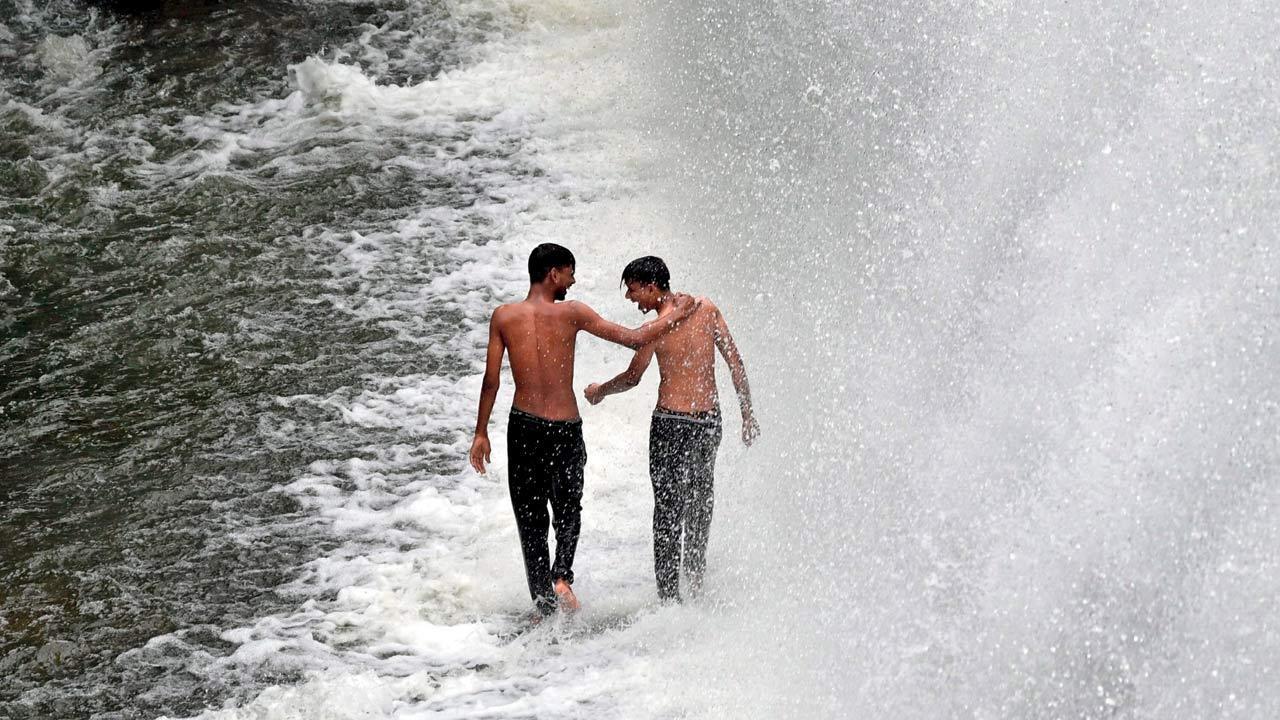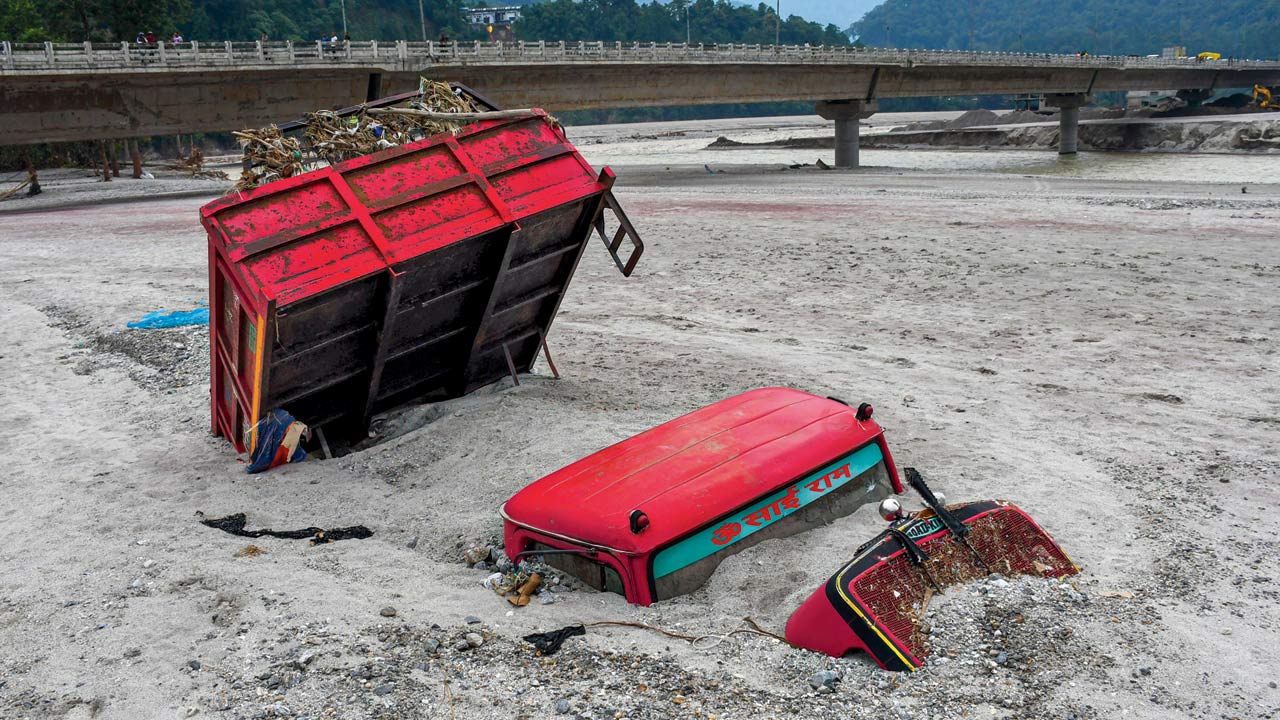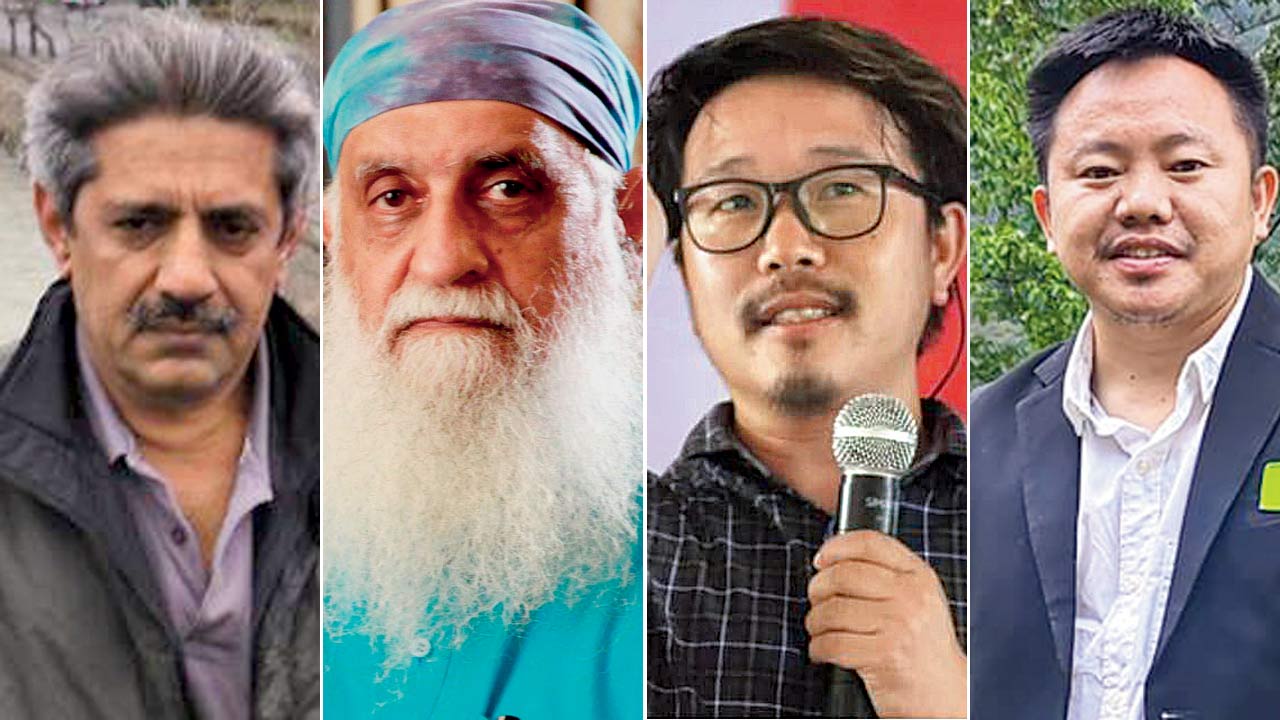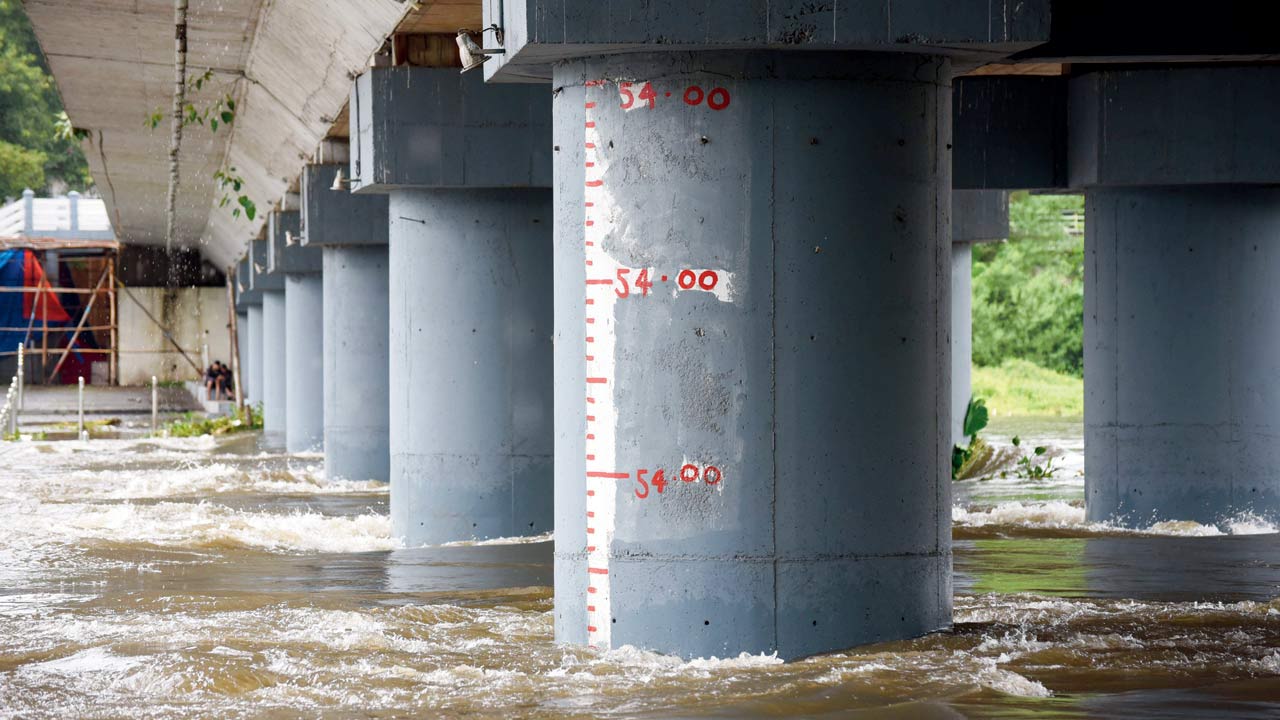The latest victim of global warming are barrages that are producing dangerous methane only to add to rising temperatures. As many of the country’s dams crumble under fiercer monsoons, we need to ask, do we need dams at all?

Powai dam overflowing on July 24 after incessant rains in the city. Not only is the over-topping of water from a dam a reason behind it weakening, but is clear indication that dams are not built keeping the changing climate in mind. Pic/Sayyed Sameer Abedi
On August 4, Punekars awoke from a Sunday siesta to find their city flooded after the authorities released 45,000 cusecs of excess water from Khadakwasla dam at 5.30 pm, following torrential rain through the day. Unprecedented downpour of 100 mm in catchment areas such as Varasgaon and Temghar caught the authorities by surprise, prompting them to open the dam’s gates to prevent a breach. This overflow gushed through the low-lying areas, prompting authorities to evacuate residents, even as the city witnessed four deaths in rain-related incidents.
Such episodes can no longer be called “freak weather”, and are quickly becoming the norm instead, as climate change exposes the country to extreme weather patterns. A new study released on August 6, titled Managing Monsoons in a Warming Climate, revealed that 70 per cent of Indian districts now experience increased frequency and intensity of extreme rainfall events. The first-of-its-kind study was conducted by sustainable infrastructure consultant IPE Global and Geographic Information System specialists Esri India and released at a symposium organised by UNESCO.
Just days before the Pune flood, on August 1, a series of cloudbursts over Himachal Pradesh led to a catastrophic dam burst at the Malana hydel project. Five people died in the resulting flash floods, while another 50 went missing. The Himalaya Niti Abhiyan, an environmental protection group, has since demanded that a safety audit be conducted at all existing dams, as well as a ban on construction of anymore mega hydel projects in fragile upper Himalayan regions.
 A vehicle seen submerged in mud in the flood-affected area along the Teesta River. A glacial lake in northeast India burst through a dam shortly after midnight of October last year, washing away homes and bridges and forcing thousands to flee. Pic/Getty Images
A vehicle seen submerged in mud in the flood-affected area along the Teesta River. A glacial lake in northeast India burst through a dam shortly after midnight of October last year, washing away homes and bridges and forcing thousands to flee. Pic/Getty Images
India’s love-hate relationship with dams is no secret. It is one of the major flashpoints over which environmental groups have locked horns with the government. But in a growing economy with constantly rising energy needs, the number of hydroelectric projects and dams has only grown over the years. According to a 2021 report by the United Nations University’s (UNU) Institute for Water, Environment and Health (INWEH), India has the third highest number of dams in the world, with the US and China taking the top ranks. The report—An Emerging Global Risk 11—also points out that out of 4,407 dams in the country, 1,115 large dams will hit the 50-year age mark by 2025.
The report states that ageing dams are gradually emerging as a development issue across many countries, but are yet to be comprehensively assessed globally. Nor has this concern been accounted for in future infrastructure planning. In fact, the first issue the report flags is that no one seems to be addressing the double-edged sword of ageing dams—the older they get, the more structurally unstable they get, even as they come under increasing pressure from extreme rainfall events.
The report adds that these climate change considerations may further accelerate a dam’s ageing process and, thus, decisions about decommissioning. Older large dams were designed using historical hydrological data and were never built for such extreme weather patterns. The increasing frequency and severity of such events can overwhelm the reservoirs and undermine dam safety.
 BMC releases water at Tansa Dam on July 25 as reports of water overflowing began to trickle in
BMC releases water at Tansa Dam on July 25 as reports of water overflowing began to trickle in
In 2023, a parliamentary panel revealed that there are 234 functional large dams in India that are more than 100 years old, with some of them even built three centuries ago. Fourty-four of these dams are in Maharashtra. The panel expressed concern over the fact that these dams had not been decommissioned yet. The commission was informed by the government that there is no system in place “to assess the viable lifespan and performance of dams”.
Himanshu Thakkar, coordinator of South Asia Network on Dams, Rivers and People (SANDRP), says, “As dams age, a major concern is that they get silted up, decreasing their storage capacity. Secondly, there is wear and tear of the gates and walls. But the more pressing issue is how the rainfall pattern has been affected by rapid and unprecedented climate change.”
Speaking to mid-day from his Delhi office, Thakkar explains, “Every dam is designed to be safe with certain inflows [how much water it takes in] and are typically designed for a one-in-100-year flood possibility. But now, because of erratic rainfall and inflow pattern, those designs have become outdated.”
 Himanshu Thakkar, coordinator, SANDRP; Ravi Chopra; Gyatso Lepcha and Ebo Mili
Himanshu Thakkar, coordinator, SANDRP; Ravi Chopra; Gyatso Lepcha and Ebo Mili
Based on a dam’s inflow designs, the authorities plan the spillway capacity, which is the path that surplus water from a dam takes when the reservoir is full. This capacity, too, is based on outdated estimations, leading to flash floods when dam gates are opened.
Thakkar highlights the looming danger clearly, stating: “Maharashtra is the state with the highest number of dams in the country. This state alone has 1,821 dams. In fact, it has more dams than Madhya Pradesh and Gujarat—which rank number two and three—put together.”
What also exacerbates India’s vulnerability to climate risk is the melting of Himalayan glaciers. Even relatively newer dams built on old climate data may not be able to withstand such events. This, says Thakkar, was one of the reasons the Teesta III dam in the Himalayan state of Sikkim was breached on the night of October 3 last year, following a glacial lake outburst flood (GLOF) that ravaged four districts. The gush of water from the melting South Lhonak glacier killed at least 42 people, while 77 were reported missing.
 Construction vehicles are seen covered in debris caused by flash floods after a lake burst in Rangpo along the Teesta River. Scientist had declared the site a hazard for months after the incident. Pic/Getty Images
Construction vehicles are seen covered in debris caused by flash floods after a lake burst in Rangpo along the Teesta River. Scientist had declared the site a hazard for months after the incident. Pic/Getty Images
Gyatso Lepcha, general secretary of Affected Citizens of Teesta (ACT), is preparing to launch a demonstration to demand the decommissioning of the dam, as well as a ban on construction of any more dams in the mountainous region. “The glacier is melting because of climate change. Building a dam in such a fragile area has further contributed to this climate change,” he says, adding that Sikkim has a total of six dams.
Lepcha, whose entire community was affected by the Teesta dam, says the loss of community and vocation has been unparalleled since it came up in 2013. “Tribals had to give up land from which they would be otherwise earning. Other than the displacement, look at what happened when the dam burst—it was death and destruction everywhere. We have still not recovered,” he says.
“Building anymore dams with such erratic weather patterns is a disastrous idea, but government after government we are seeing no change in policy. Dams are just ticking bombs,” he stresses.
 Flooded Mutha River after 13,981 cusecs water released into river from Khadakwasla dam, which filled to capacity following continuous rain, on July 30, 2019, in Pune. History repeated itself on August 4 when 45,000 cusecs were released into the already flooded city. Pic/Getty Images
Flooded Mutha River after 13,981 cusecs water released into river from Khadakwasla dam, which filled to capacity following continuous rain, on July 30, 2019, in Pune. History repeated itself on August 4 when 45,000 cusecs were released into the already flooded city. Pic/Getty Images
Lepcha is not wrong about dams heightening the risk of climate change. In 2016, Swiss scientists studying emission patterns at 1,500 hydropower plants across the planet found that methane emissions from dams can sometimes be equal to that of a coal-fired power plant that produced the same amount of electricity.
In another study that was conducted the same year and funded by the US, researchers found that rotting vegetation in the stored water in dams emit about a billion tonnes of greenhouse gases every year. This organic matter is dragged into the dams as rivers and rainwater flow in, says Thakkar, adding that methane is a greenhouse gas that’s 24 times more potent than carbon dioxide, speeding up global warming that much faster.
Methane from dams forms 1.3 per cent of total annual human-caused global emissions. This raises pertinent questions about whether hydroelectricity can even be considered a sustainable energy source. In a welcome step forward, in 2022, the US government included methane emissions from dams in its annual emissions report to the United Nations Framework Convention on Climate Change for the first time.
On the other hand, says Thakkar, in India, “no one wants to talk about this. There are too many powerful people involved and too much money exchanges hands.”
Lepcha says India must re-examine its stand on hydroelectric projects. “The whole idea of building a dam as the answer to electrical problems is preposterous. What they have ended up doing is destroying our communities and adding to climate change. Meanwhile, downstream they are drying up a whole river,” he adds.
Ravi Chopra, research scientist at People’s Science Institute Dehradun, is a veteran conservationist and was in the news last February when he quit as chairman of the high-powered committee (HPC) on the Char Dham rail route project after terming it “an assault on the Himalayas”.
Chopra is no stranger to Maharashtra’s unique problems either. “The biggest problem for Maharashtra would be dams on the western sides of the western ghats because they receive the brunt of the rainfall. Many of the dams here are old and the older the dam gets, the worse the problem is. They were not designed with adequate data to begin with, and they are not certainly not designed for new rainfall patterns led by climate change,” he says.
The erosion of watershed areas (which channel rainwater to a water bodies) around the dams has made things worse. “Watershed areas that are extremely denuded have nothing to hold soil down on the slopes, and this silt flows into the dam affects its capacity,” he says.
This decreases the dam’s capacity, prompting engineers to then be overzealous about filling it up every time it rains, depriving downstream areas of crucial water supply. “Marathwada dams, like those near Nagpur, see extreme evaporation due to rising temperatures and the dam engineers will make sure that the dam is [always] filled up. Then when the dam is close to overflowing, the water is released, resulting in flooding,” he adds.
Like Marathwada, dams and lakes in Mumbai too have been drying up in the extreme heat, begging the question: are these reservoirs even the best option for water storage amid global warming? Mumbai draws its water from Tulsi, Tansa, Vihar, Bhatsa, Modak Sagar, Upper Vaitarna and Middle Vaitarna reservoirs—as recently as March, the water stored there level dipped to 37.9 per cent of the total capacity—the lowest in the last three years.
Ranjan Penkar, retired irrigation officer from the Maharashtra Water Resources Regulatory Authority (MWRRA), doesn’t agree that Indian dams are ill-equipped to handle the influx of water. “Structurally, the dams are fine. I feel that when there is an increase in water level due to a sudden onslaught of rain, it is mostly because of a lack of alertness. If the rainfall and water level is monitored properly and the excess is released accordingly, things will not be as bad,” he says.
Penkar believes that increased settlements downstream, in areas where dam overflow is released, is what’s causing the floods. “Illegal settlements are a big issue and need to be dealt with swiftly. As far as dam inspections are concerned, there are detailed checks both pre- and post-monsoon. A visual inspection is done and we then determine where repairs need to be made,” he adds.
When we ask an MWRRA officer if there is an emergency fund to swiftly tend to any observed damage, they say, “Not really, you have to make a report and send it to the authorities, and then the money is released.”
Mechanical engineer Shripad Dharmadhikary, an alumnus of IIT Bombay and former member of the Narmada Bachao Andolan (NBA), runs the Manthan Adhyayan Kendra in Pune, where he researches dams and commodification of water, as well as water and energy policies. “We have the largest number of dams in the country but it is true that we have not changed the SOPs [standard operating procedure] since we started building them. For example, the rule curve— which specifies the storage level or how much empty space to be maintained in a reservoir during different times of the year—is still calculated based on data from 50 years ago. There is no one asking the government what they are doing about it. This should be a big concern for us, but the public is not very aware about it,” he adds.
Neither is there any SOP on decommissioning of dams in India. As a result, there is no official record on how much such an initiative might cost. The nearly-130-year-old Mullaperiyar Dam in Kerala has been a point of contention between the state and its neighbour, Tamil Nadu, for close to four decades.
India may have to dig a little deeper for a solution. Thakkar says most of the water used by us comes from the ground, and that the government ought to invest in natural aquifers instead. “Small water containment units need to be created in catchment areas. This will recharge natural aquifers,” he says. The next step would be to pump the water safely. “The advantage would be a decentralised storage system. The cost of pumping out the water to nearby consumption points will also be far less than what’s spent on dams,” he adds.
The people of Arunachal Pradesh have been one of the most vocal opponents of dams and hydel projects in the country.
Among them is Ebo Mili, 32, who has been arrested and preventively detained thrice for opposing the construction of mega-dams in the state. “Other than what will happen to the environment, one of our biggest fears is the fact that we, as indigenous and tribal communities, are very small in number. For example, my tribe has a total population of 10,000. When the dam [which dam] is built and our communities destroyed, who will bother about our land and how the dam affects our food production and livelihood? Right now, we are being told that it will solve all our problems as the hydroelectricity produced will gives us 24-hour power supply, but no one is talking about how communities are destroyed and ecosystems are lost in the blink of an eye,” Mili tells us over the phone.
Mili, who was practising law in Delhi, has moved back to his home state as he couldn’t stay away from the way of the tribe for too long. Nestled in the hills, Mili’s village has only just begun feeling the effects of global warming. Table fans are all the rage now, he says. Building more dams there will only increase emissions and make things worse, he adds.
Did you know?
Maharasthra has one of the five oldest dams in the country at Dhamapur, which was built in the 1600s
70 per cent
of Indian districts experience extreme rainfall events, as per study
234
No. of dams in India that are over 100 years old
44
No. of dams in the state that are over 100 years old
Not just an Indian problem
There are more than 91,000 dams across the US. Every four years, the structural integrity of infrastructure, including dams, is assessed. The most recent report card estimates that 70 per cent of US dams will be more than 50 years old by 2030. Many of these dams have emergency action plans, but the report also estimated that 2,300 potential high-hazard dams lack such plans. States like Michigan are also turning to a controversial solution to combat environmental damage and rising costs
of upkeep—removal of obsolete dams.
 Subscribe today by clicking the link and stay updated with the latest news!" Click here!
Subscribe today by clicking the link and stay updated with the latest news!" Click here!










